JSF Program - Boeing X32
Even before the competition, the military department of the Boeing airline participated in the following programs:
- naval promising multi-purpose fighter AF / X;
- Multifunctional fighter Air Force MRF;
- project “CALF” from DARPA.
And although not in one of them in the future, the Boeing branch is not involved, this made it possible to gain experience and create best practices for the JSF fighter project. The main problem for Boeing, because of which, in fact, there was a rejection of Boeing projects, was unacceptable for the customer the price of one aircraft.
In Boeing, the entire concept of aircraft creation was revised, and the concept of the thick triangular wing, previously presented for the CALF project, is adopted on the “wreckage” of the projects. This concept helped to achieve the required range / combat load characteristics. Due to the placement in the wing of the main fuel stock, the weight of which reached 40 per cent of take-off weight, these indicators improved more than 2.5 times in comparison with the F-16 and F / A-18 aircraft. The maneuverability of the aircraft was not affected. In the design of the aircraft used the most modern technology used by the airline when building a civilian Boeing-777.
The unification of the aircraft was decided by the use of a high-profile plane using a delta wing, a V-shaped tail, an air intake of a bow-type design with compartments for installing weapons on the fuselage. Initially, the aircraft was planned as a system. weaponsso left him. The wing of the aircraft remained constant constant, which affected the fit of the fuselage to the wing, and not vice versa. It was roomy enough for the 8.6 tons of fuel and internal niches for the chassis. The design of the wing multi-spar with a covering of composite materials. This allowed reducing weight, improving damage resistance, and most importantly, reducing cost. Wing spars are made using Sine-Wave technology (F-22).
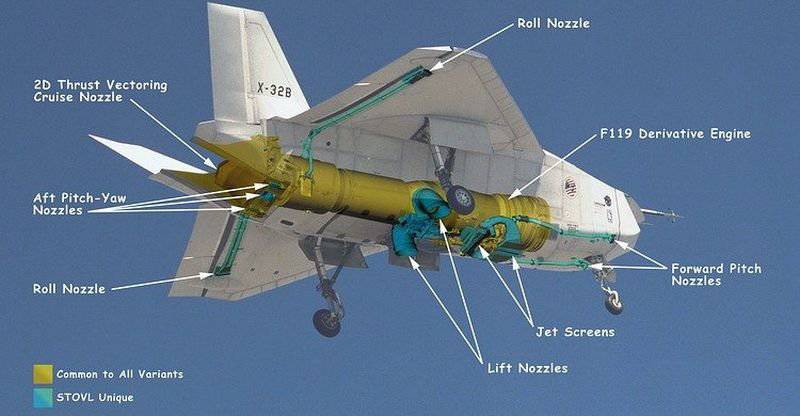
Studies conducted in the 1995 year have shown that a few keels lined out would increase the flight secrecy and save weight, which they later used on the Boeing X-32. This decision on the statements of the developers will give the aircraft better handling. Due to restrictions on the aircraft parking area, it was necessary to limit the length and span of the wing.
The direct control of the thrust vectoring was complicated by the need to perform a lifting nozzle in the center of mass, and an engine in the bow. This led to insufficient space under the side air intakes - the decision is made to create and install a subcabin unregulated air intake having a lower part protruding forward. Further, it was fully optimized for all speeds and required criteria.
For the implementation of the operation of the engine with a shortened take-off / landing, when increased air flow is required, the shell in the front part of the air intake moves forward and opens an additional slot for air intake. The chassis of the high performance aircraft according to the high-profile layout and avoiding the effect of "suction" when shortened takeoff / landing.
Design and construction of the Boeing X32
The aircraft consists of 2 parts - the underwing and the anteroposterior part of the separate assembly. The front part was built in St. Louis, she carried the cockpit, on-board radar and avionics. The tail section was built in Seattle, she carried the engines and compartments for the payload. Wing collected in Palmdeyme.
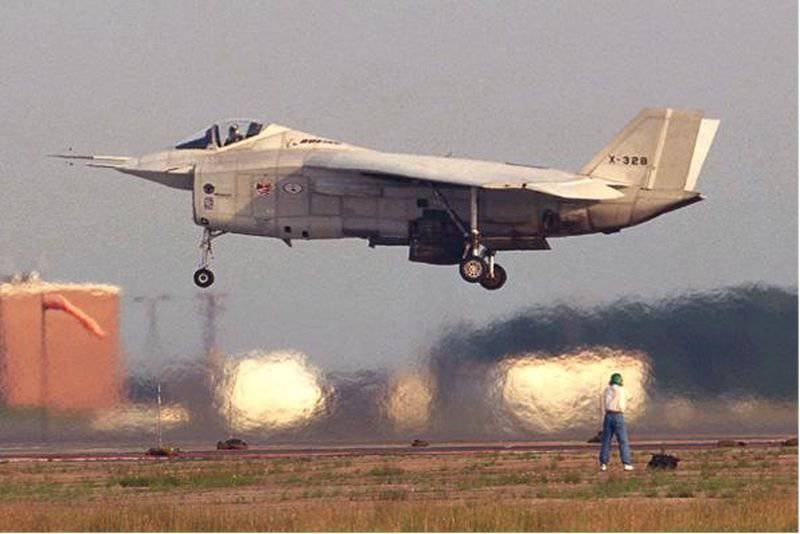
Compartments for the installation of the payload received a large volume due to the wide fuselage. Installation of weapons was carried out conveniently and simply. The secrecy of the aircraft in the use of weapons provided the possibility of using weapons from the compartment, which is deployed not in the direction of the target. Each compartment could accommodate an AMRAAM 2 missile or one missile and one JDAM bombs. The compartments had a reserve for modernization - if necessary, install more bulky weapons, the length of the compartments increased.
At the beginning of 1999, the updated requirements for the aircraft under the JSF program come:
- increase in combat take-off weight;
- increase in the weight of weapons in the course of landing on the ship (aircraft carrier);
- tightening the scope of maneuverability at high angles of attack;
- Improving the stability of the aircraft on the course.
These requirements put a "cross" on the existing configuration of the delta wing and tailless scheme. The participation of the Boeing X32 barely managed to defend. Funds allocated by the program are redistributed. Work is beginning on the development of an updated architecture for the entire combat complex. Despite many difficulties, the main work on the Boeing X32 continued according to, the aircraft with a smaller wing and the UHT system “dropped out” of the customer's requirements. In this regard, urgent measures are taken to reduce the weight of the airframe.
At the time of the redesign of the 400 aerodynamic design from 750, millions of dollars were spent on building demonstration aircraft and updating the BC architecture. However, the Boeing X32 project was continued, and the general schedule (updating of the aerodynamic scheme) came to the calculated year by 2001.
Changes:
- the rear edge of the wing gets the sweep + 20 degrees;
- some of the area of the wing moved into the area of horizontal tail;
-the lower protruding part of the air intake gets a positive sweep.
Unification Boeing X32
In 1998, the airline Boeing decides to reduce the overall unification of the JSF program. The aircraft for the WBU, MT, the United States Navy and the British Navy from 85 percent to 70. Work has been carried out to identify areas where it is required or appropriate.
SUVVP differs from the deck and ground version of the trimmed wing (9.25 meter), shorter by about 40 centimeters, which led to a decrease in weight by 135 kilograms. Installed vertical thrust production system. In Boeing, they assured that before mass production, using modern mass-saving technologies, all options will have the same length, which will raise the level of unification to 95 percent, and reduce the cost price of one copy. The deck version receives a landing hook, a reinforced chassis with a two-wheeled nose strut, as well as a reinforced design of the rest of the chassis and airframe. The land version gets the VK27 Mauser automatic cannon.
Program Boeing X32
The program consists of three steps to reduce technical risk:
- The first - the creation and testing of demonstration aircraft;
- the second - the creation of the architecture of the airborne armament complex, improving stealth characteristics, with the creation of a simulator for testing and simulating combat missions (using Boeing 737-200, installing equipment and systems on it to conduct various tests and suspension 1: 1 to refine the ESR );
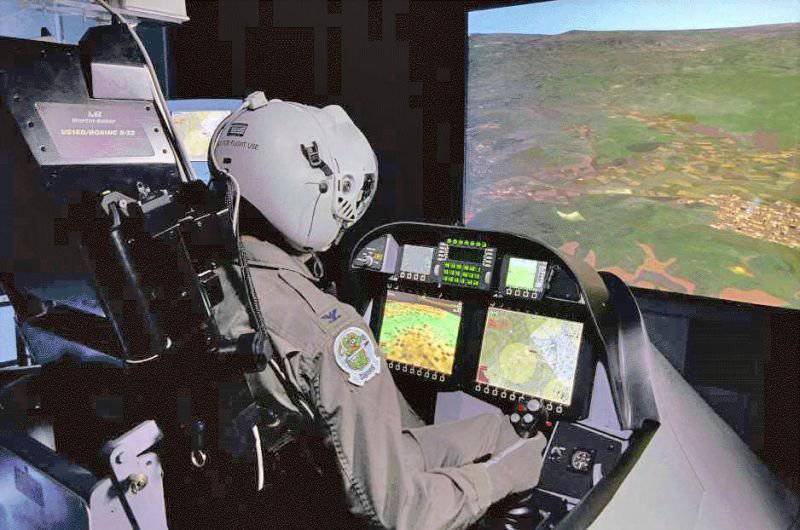
- the third - bringing the aircraft to the exact requirements for the project in serial configuration.
The flying laboratory was used in testing the avionics created by Raytheon. It included the installation on board the full version of the complex. The architecture of the complex is open, which allows for a “painless” modernization of the complex. Avionics experienced more than a year (the entire 2000 year). In the middle of 2001, using the avionics, a test was carried out of the weapons of the JDAM bombs, which were considered successful. At this time, several successful simulations of take-off, combat use and landing of a fighter by combatant pilots of the United States Air Force were carried out on simulators.
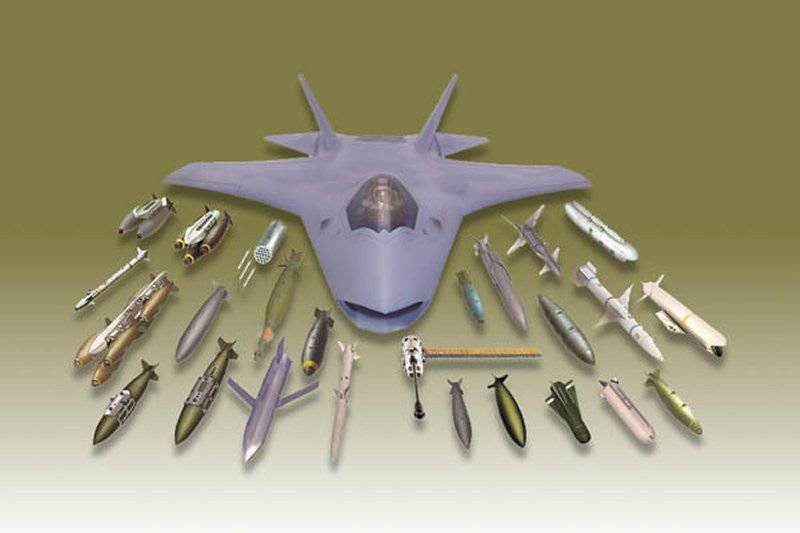
According to the program, the architecture of the combat complex can take a fairly wide range of weapons in the compartments for the destruction and destruction of enemy’s surface / ground / air targets:
- tactical missile "JASSM" / "SLAM-ER";
- guided anti-tank missile "Maverick";
- anti-radar missile "HARM" / "ALARM";
- Adjustable aerial bomb "JDAM" / "Peyvay";
- Free-fall bomb caliber 900 / 450 / 225 kilogram;
- bomb cassette.
- air-to-air missile ATM-120 AMRAAM;
- MD “air-to-air” AIM-9M “Sidewinder”;
- rocket "AIM-9X".
The JSF program in which Boeing Airlines participated was one of the largest in terms of volume and requirements. The Boeing management believes that it has everything it needs to carry out the program: a business plan with calculated degrees of risk, capacity and willingness to perform, a trained, qualified team. Technical risk has been reduced by developing more 60 special programs.
Maintenance
With the maintenance of the airline has always been in order, as accumulated vast experience in the civil sphere. Typically, the cost of the aircraft grows in view of its maintenance, but, having experience in the civilian field of aviation services, Boeing could offer to carry out these works at any airbase, which led to significant cuts by the customer to maintenance funding. For this, they planned to use computer software used on Boeing-777. The “JDIS” program could “prompt” the aircraft for the time of various repairs, availability of the necessary equipment and the material base in the location. The goal of the program is to provide the aircraft with information on the availability of the necessary spare parts in an acceptable home base during the day in the United States and within two days at any place outside the country. Ensuring collaboration with fault detection systems. The planned economic gain is up to 30 percent for one machine, reduction of technical staff for aircraft maintenance by 40 percent, increasing the reliability of equipment and systems to 50 percent.
Single team
The Boeing pride is a team of specialists of various profiles assembled into one. The team included the 32 man, who represented the main divisions: designers, technical specialists, representatives of subcontractors and the customer. Having worked together during the project, the team was able to perform the assigned tasks in a short time. Creating a single team refers to the 1995 year. At one of the meetings, which was attended by representatives of the customer, contractors and branches of the company, it is decided to create a new team.
The team at one time invited representatives of the British units from the "BAE" and "GEC Marconi." This decision was implemented with great difficulty. In the future, this led to an improvement in the project as a whole, receiving the JSF program of international status. All parties were interested in one-on-one projects (American JSF and English ASTOVL), among other things, the British strengthened the project financially. They participated in the development of documents and drawings, and in the process of creating demonstrators. A single team was divided into groups to clearly perform specific tasks in the areas.
Fighter demonstrators
X-32A
The nose of the X-32A was assembled in St. Louis, ahead of schedule. In addition, it was performed lightweight, and the cost eventually turned out to be less than planned. Successes in the assembly of the structure are primarily associated with the use of computer spatial modeling. At the end of March 1999, the assembled nose is sent to Palmdale to assemble the overall structure of the demonstrator. The use of new development technologies and the well-established relationship with subcontractors enabled the latter to begin work on the creation of equipment and units, regardless of the overall schedule of work. This all led to the following results - the time required for development decreased by 40 percent, the assembly - by 30 percent.
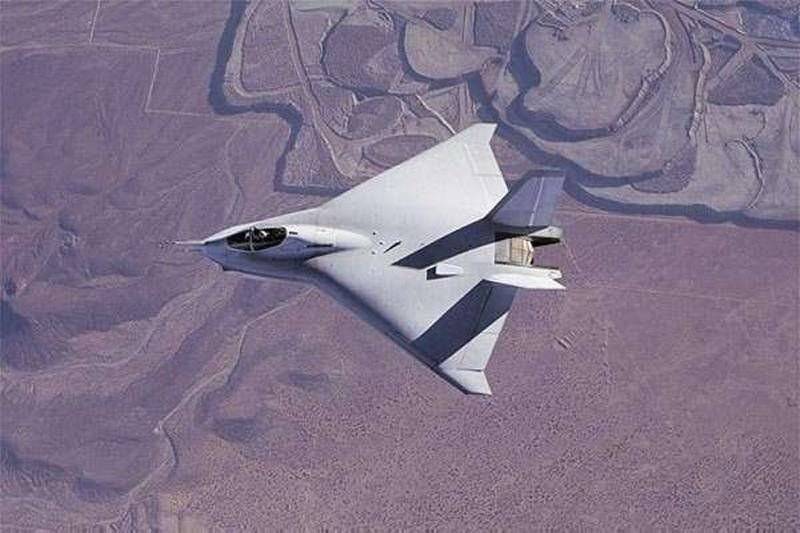
Both demonstrators named “X-32A / B” were ready by the end of 1999. They were the first JSF demonstrators built; Lockheed-Martin’s competitors built their X-35 demonstrator aircraft early next year.
May 2000 of the year. The stage of testing the steering of the X-32A is completed. In the course of ground tests even a kind of record was set - 102 km / h, on which braking and control were carried out. Later runs and jogging at higher speeds.
Departures of the first demonstrator started in mid-September 2000 of the year. According to the plans, they should have been held in May, but the strikes at the plant led to the postponement of the main date.
23.09.2000 of the year. Edward Air Base The first flight of the X-32А demonstration aircraft. The wind prevented him from taking place two before. Flight time is 50 minutes, altitude is 3 kilometers, speed is at least 320 km / h. The pilot confirmed that the aircraft behaved in the air, as well as on the simulator. This behavior was achieved again thanks to the computer technology that created its computer model for the simulator. Later flights were conducted to determine various characteristics at different heights and speeds. All flights are divided equally between projects for the Navy and Air Force.
The X-32А demonstrator successfully demonstrated the possibility of horizontal take-off / landing for the Air Force, as well as the possibility of a deck option for the Navy. This degree of unification was one of the basic requirements of the program. He demonstrated satisfactory handling when landing on a ship at a high angle of attack and partial possibilities of a shortened take-off of SUVVP.
Significant events of flight tests X-32A:
- 18.09.2000 of the year - the first unofficial flight, flight from the factory to the base Edward;
- November and December 2000 - test landing approach at low speeds for the Navy;
- December 2000 of the year - the first refueling of the aircraft in the air. X-32A at an altitude of 6.1 km and speed 435 km / h took the refueling bar from the KS-10 tanker and simulated refueling;
-21.12.2000 of the year - X-32А goes to a supersonic speed at an altitude of about 9 kilometers;
- January 2001 of the year - tests of the payload compartments, both with and without weapons, for vibration and other stresses in the air.
In total, the demonstrator completed 66 sorties, approximately 50.5 hours, and in February 2001 completed the flight test program. These tests are recognized in the Boeing as one of the most successful flight tests of the aircraft.
X-32B
The second demonstrator, called X-32B, was equipped with an engine system with a rotating thrust vector. The main purpose is to demonstrate the capabilities of a shortened take-off and a flight. Before that, the entire system successfully passed all ground tests - more than a thousand times switching from the thrust mode to the vertical horizon and back. They were carried out at the facilities of the Pratt-Whitney company. The engine was installed on the demonstrator "X-32В" for testing vertical thrust. At the end of winter early spring 2000, bench tests were carried out. In 2001, the stage of the steering test and progazovok begins at speeds no more than 110 km / h. The behavior of X-32В corresponded to the behavior at this stage of X-32А.
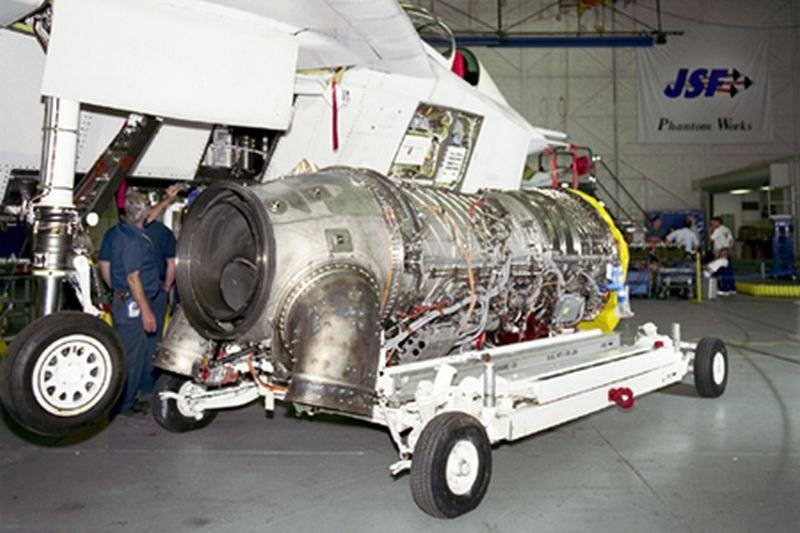
X-32А rises in the sky in the first 2001 of the year in March. All flight tests were held in the same place as the tests of the first demonstrator. Externally, the differences of the aircraft were small, for example, the lower lip of the air intake underwent changes. By 7.03.2001, the ground test program was completed. The nozzle of the engine F119-614 was rejected at the maximum possible angles with the achievement of the thrust of the maximum value in the unformed mode. Progazovki conducted over a special pit and were considered successful.
The transition from horizontal to vertical traction and back should be as fast as possible (1-3 seconds). This possibility was confirmed by the conducted simulations on a computer model and simulator. SU aircraft and engine are recognized as suitable for testing in the air.
Fate Boeing X-32
The revealed problems of flight characteristics, weight of the vehicle and carrying out difficult structural changes to the Boeing X-32В allowed the competitor to win the X-35 aircraft. This loss of contract has been a hard blow for Boeing - the military contract for a unified fighter is the largest in stories military aircraft industry. However, the airline Boeing bravely suffered a stroke and plans to continue to use many of the developments and technologies from the Boeing X-32 in future projects.
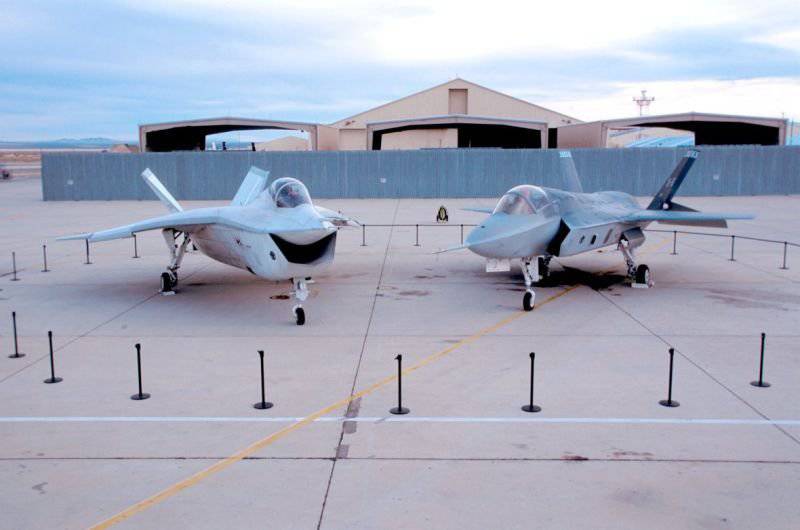
Key Features:
- crew -1 pilot;
- conventional wing / GDP - 10.9 / 9.1 meter;
- Length - 13.6 meters;
- average wing area - 55 sq.m;
- weight min / max - 10.2 / 22.7 tons;
- GDP weight min / max - 11.1 / 27.2 tons;
- fuel stock ordinary / GDP - 6.8 / 7.7 tons;
- speed cruiser / max - 1.5 / 1.7 M;
- High-altitude ceiling - 20 kilometers;
- The payload is placed on the 8 suspension nodes.
Information sources:
http://www.dogswar.ru/oryjeinaia-ekzotika/aviaciia/6487-opytnyi-istrebitel-b.html
http://www.airwar.ru/enc/xplane/x32.html
http://www.youtube.com/watch?v=1BZGgvhqs5g
http://www.youtube.com/watch?v=IwyVuFNec-Y
Information